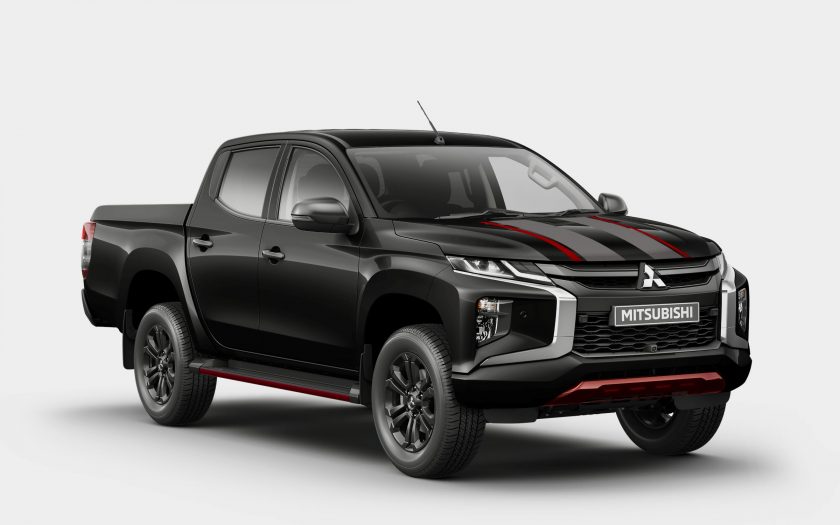Chris Riley tests the 2023 Mitsubishi Triton Sport Limited Edition with pricing, specs, ride and handling, safety, verdict and everything the over-50 driver needs to know.
Summary: Yet another “limited edition” designed to clear stocks before the new model arrives.
2023 Mitsubishi Triton Sport Limited Edition crew cab ute
Pricing: $60,926 (GLS Sport Edition auto, driveaway)
Options fitted: hard tonneau, tray liner, tow bar, mud mats
Warranty: Ten-years/200,000 km (when serviced by Mitsubishi dealer), otherwise five-years/100,000km
Safety: Five-star (2015, so expired)
Build location: Thailand
Engine: 2.4-litre turbo intercooled 4-cylinder diesel
Power: 133kW at 3500rpm
Torque: 430Nm at 2500rpm
Transmission: 6-speed automatic, all-wheel drive
Body: 5305mm (long); 18175mm (wide); 1795mm (high)
Weight: 2000kg
Braked towing capacity: 3100kg
Wheels: 18-inch alloy
Tyres: 265/60 R18
Ground clearance: 220mm
Turning circle: 11.8m
Fuel tank capacity: 75 litres
Official consumption: 8.6/100km (diesel)
Consumption on test: 8.6L/100 (600km)
seniordriver consumption on test: not tested
[review]
A Mitsubishi Triton with fashionable black bits.
There have been a few of these along the way and this probably won’t be the last.
Mitsubishi has become the master of squeezing the most out of its long-serving models with minor upgrades.
This one dates back to 2015, but was facelifted in 2019, with changes to the front and rear design – the last time we drove the vehicle.
There’s an all-new Triton on the way, due for launch later this month overseas, and that means making way for it with special editions like this one to stimulate sales.
Based on the GLS with the Deluxe options pack, Triton Sport Limited Edition features a bunch of extras to make it more appealing – both visually and functionally.
What’s it cost?
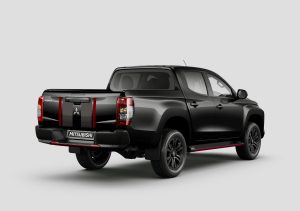
Sport is available in dual cab format with a tub only, in a choice of white or black, with black wheels and trim.
Skid plate, side steps and rear apron feature maroon accents, while the bonnet and tailgate get some tasteful GT stripes (not the roof or tonneau cover though).
Inside, the cabin is decked out in a combination of black leather and red stitching.
Triton is priced from $30,740 for the 4×2 GLX single cab chassis with a manual transmission.
The 4×4 dual cab range kicks off with the GLX with an auto, from $44,240 driveaway.
This is followed by GLX+, GLX-R, GLS, GLS Sport Edition, and range-topping GSR with the works for $65,740 driveaway.
Our test vehicle, the Sport Edition with a six-speed auto, is based on the GLS and priced from $60,926 driveaway – that’s $4500 more than GLS.
In addition to the trim and spin, the Sport adds a power-adjust driver’s seat, heated front seats, leather door inserts and a 360-degree camera.
Two-zone climate air is supplemented by a roof-mounted blower to distribute air to the rear seats.
Other features include LED headlights, auto high beam, auto lights and wipers, auto dimming rear view mirror, cruise control, speed limiter, side steps, front and rear parking sensors, auto high beam, auto lights and wipers and an auto dimming rear view mirror.
Although the test vehicle was presented with matching hard tonneau, tray liner, tow bar and mud mats – these items are in fact extra.
Infotainment consists of a 7.0-inch inset touchscreen, with Bluetooth, AM/FM and DAB+ digital radio, wired Apple CarPlay and Android Auto connectivity, with six-speaker audio.
Unfortunately, satellite navigation is not part of the deal with any grade, which is weird given that it was the last time we drove Triton.
It’s alright to leave things off the list, but not recommended to remove them.
There’s also two USB, an HDMI port and 12-volt socket at front of the console, and another two USB ports in the rear, plus a 12-volt outlet inside the console box – but no 12-volt outlet in the tub.
Safety consists of seven airbags, including a knee bag for the driver, rear view and 360-degree cameras, plus autonomous emergency braking with pedestrian detection.
There’s also Lane Departure Warning (LDW), Blind Spot Warning (BSW), Rear Cross Traffic Alert (RCTA), Lane Change Assist (LCA) and Ultrasonic misacceleration Mitigation System (UMS).
Auto braking works up to a speed of 80km/h with stationary objects, or 200km/h if they’re moving.
The mis-acceleration thingo reduces the chance and severity of hitting obstacles up to four metres away if the driver mistakenly presses the accelerator pedal instead of the brake at speeds of up to 10km/h.
Sounds good so far, but – and it’s a big BUT – Triton’s five-star safety rating has expired and it needs to be re-tested.
It was last tested in 2015, and time as they say has moved on since then.
A 10-year/200,000km warranty applies to vehicles that are serviced exclusively within the Mitsubishi dealer network.
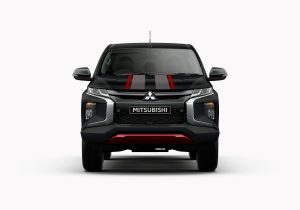
What’s it go like?
At 5305mm long, Triton is up there in terms of size, yet smaller than others.
That means slightly less leg and side-to-side room. Head, leg and shoulder room are adequate without being squeezy.
The rear seats easily accommodate a couple of teenagers, but three full grown adults could find it a bit cosy, with side steps and grab handles for each door to make getting in and out easier.
The tub itself measures 1520mm in length, 1470mm in width and 475mm in depth and can carry just over 900kg of payload, while it’s rated to tow a 3100kg braked trailer.
Triton is powered across the board by a 2.4-litre turbocharged diesel engine, with a choice of 4×2 or 4×4, six-speed manual or six-speed automatic transmissions.
The diesel produces 133kW of power at 3500 rpm and 430Nm of torque, the latter at only 2500 rpm.
Fuel consumption ranges from 7.8L/100km to 8.6L/100km, depending on grade and transmission.
Our six-speed Sport automatic is good for 8.6L/100km.
Mitsubishi’s Super Select II all-wheel-drive system lets you choose between rear- or all-wheel drive, high or low range and also has a lockable rear diff.
Steering wheel paddles are provided if you want to shift gears manually, with drive modes for rock, gravel, mud/snow and sand.
The standard tyres on the Sport are road-biased, but okay for most needs.
Triton is a likeable enough ute.
It’s easy to drive, with a reasonable 11.8 metre turning circle and feels unpretentious even with stripes.
On anything but well-formed tarmac, however, the ride quickly deteriorates, becoming jiggly with plenty of backlash through the steering wheel.
The backlash means you need to keep an eye on the road.
Looking at the old-style analogue instrument panel, it’s remarkable how little has changed over the years.
There’s no physical volume control or tuning dial for the radio and the instrument cluster lacks a digital speed display and speed-sign recognition.
But at least the instruments are clear and easy to read.
Sadly, it misses out on adaptive cruise control which we’ve grown to like.
Off road, Triton is more than competent, even with road-biased rubber.
With 220mm of ground clearance, low range and a locking rear diff (high or low), it has all the makings of adventure.
We took it paddock bashing for an hour or so over mud, loose rock and the odd water crossing – and it didn’t miss a beat.
The lack of built-in navigation proved to be problematic and getting Android Auto up and running was a trial as usual.
And when you run out of phone reception, you also run out of directions.
We also had a bit of fun trying to get Hey Google to play music, specifically children’s songs.
While it understood requests, what emerged from the speakers was certainly not what we asked for.
In the end it became a bit of a game.
Opening and closing the big boot lid was hit and miss too.
Sometimes it was reluctant to unlock and when closing unless you pushed down with a hand extended to each corner, one side tended to remain unlatched (which wasn’t evident).
We clocked up about 600km of mainly country driving over the course of a few days.
With a 75-litre tank, it doesn’t seem to use much fuel either.
I’d like to quantify this, but of course I’d forgotten about Mitsubishi’s crazy trip computer which continually resets no matter what you tell it.
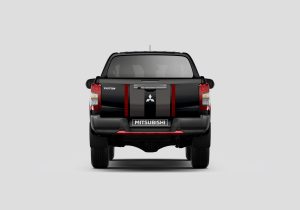
What we like
- Not too flashy
- Lockable tonneau cover
- Confident off road
- Reasonable turning circle
What we don’t like
- Jiggly ride
- No sport bar
- No built-in navigation
- Cruise control isn’t adaptive
- No digital speedo
- no speed-sign recognition
- That bloody trip computer
What over-50s drivers need to know
Like any ute, you sacrifice ride quality and ease of entry and exit.
But you get a lot of utility in return and a ute is a good choice if you want to tow a van.
It might be a bit long in the tooth, but the Triton has always traded on value for money and the Sport Edition is no exception.
We like to do a bit of country travelling and a 4×4 ute with a lockable tray is an attractive proposition, particularly with the ability to go off road and tow a van.
Then there’s the 10-year warranty (so what if it means servicing the car where you bought it).
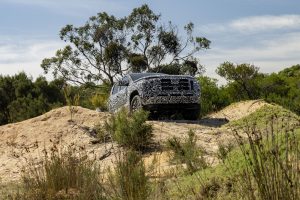
seniordriver comments
The current fad for so-called sports utes completely mystifies us, but there’s no denying their popularity.
As usual, Mitsubishi tends to lead the category for value, perhaps because they extend their model life so far. Paying a small premium over the GLS gets you a more distinctive ute, so there will be plenty of appeal to buyers who want to look just a little bit different. However, popular options will add to the price.
Like Chris, we’d be concerned about the expired ANCAP safety rating; a lot of safety features have changed since 2015.
Mitsubishi’s 10-year warranty (as long as you have it serviced by a Mitsubishi dealer) is class-leading and adds to the appeal of the Triton.
We really object to having to use a phone for sat nav, and as Chris points out, once your phone is out of reception range, you are also out of directions. And that’s probably when you need them the most.
If you plan to tow a caravan with the Triton, be aware that the towing capacity of 3100kg is a little less than other big utes, although Mitsubishi assures us they err on the side of caution when quoting towing capacity. And if you are planning to tow a caravan, you’ll need the hard tub cover for security.
